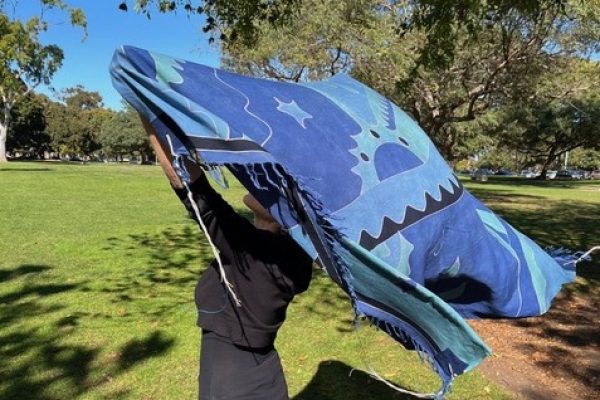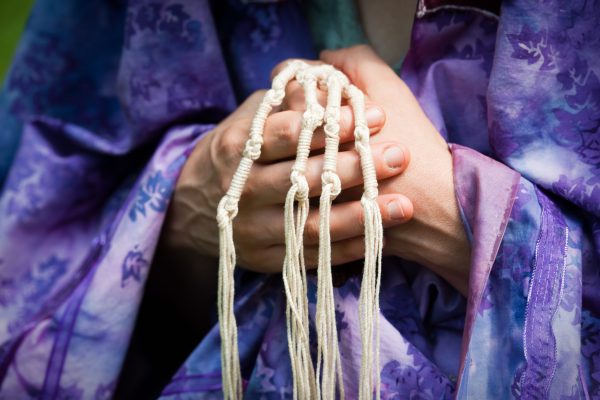Many tallitot come with pre-tied tzitzit, but choosing to tie one’s own tzitzit can bring contemporary meanings to the ancient practice of wearing a Jewish prayer shawl. A tzitzit-tying ritual can also infuse a tallit with blessings that can surround its wearer each time the tallit is worn.
This ritual is appropriate for B’nai Mitzvah students, adults choosing to wear a tallit for the first time, or longtime tallit wearers who have recently acquired a new tallit.
The ritual begins with the assembled group sitting in a circle. A table, large enough to spread out the tallit, should be either in the center of the circle or off to a side. The tallit wearer can hold the tallit and its to-be-tied tzitzit strings, or these items can await their use on the table. If the local custom is to cut tzitzit strings, a scissor can also be prepared.
(In an effort to be inclusive, gendered pronouns alternate throughout this ritual. A full list of citations and acknowledgements follows the instructions.)
I. WELCOME
Hiney mah tov umah na’im / shevet ahim gam yahad
Hiney mah tov umah na’im / shevet ahayot gam yahad
Behold, how fine and how pleasant when families (brothers, sisters) dwell together!
(Psalm 133, via Kol Haneshamah)
II. OPENING KAVANNOT
These kavannot (or others chosen by the leader or tallit wearer) can be read chorally, by volunteers, or by individuals who the tallit wearer wishes to honor.
Leader:
Traditional Jewish practice offers rituals for many lifecycle events, but tzitzit tying is relatively new ritual territory. Let’s start by reading a few quotations about creating Jewish ritual in general, and wearing a tallit specifically.
Reader 1:
“‘A tallit service, there’s no such thing,’ I hear my grandfather say. . . [But] Torah is not in heaven alone, not with my grandparents, and not even with God. When we proceed to innovate Jewish rituals with the best intentions: love, respect, learning, integrity, and responsibility for Jewish communities, Torah is here, with us.” —Vanessa Ochs, Inventing Jewish Ritual
Reader 2:
“For me . . . the feeling that this was my garment and that I was entitled to wear it meant I had to do more than grab one from the basket or rack by the sanctuary doors. [For a handmade tallit: I had to create my own tallit. I had to engage in planning and thinking about it for a substantial amount of time.] This decision-making forced me to explore, on a very physical plane, what the tallit was going to mean to me . . . It had to be large enough for me to feel wrapped and held . . . It had to be decorated so that I would always be amazed by its appearance. Its colors had to fill my heart and make me happy. Its fabric had to be something that could catch my tears without staining and feel good and comforting—not itchy!—against my skin. I needed my tallit to be bright, vibrant and alive.” —Yael Shuman, “The Power of a Prayer Shawl”
Reader 3:
A kavannah of focus and attention: “‘Wrap yourself in light as a garment, stretch out the heavens like a curtain’ (Psalm 104:2). I gather myself to pray, drawing together my scattered attention in order to focus. I look for the light within me and in so doing I find that my individual self is connected to the universe stretched out before me.” —Rabbi Michael Strassfeld, A Book of Life: Embracing Judaism as a Spiritual Practice
III. Preparation
The tallit wearer can now take a moment to focus on the physical materiality of her new tallit. This is an opportunity for her to speak about her tallit‘s provenance and/or any special features of the tallit itself. For example, was it made by someone important to her? Was it purchased at a significant time or in a significant place? Do the textiles, colors, or patterns carry special meaning? If the tallit‘s atarah contains a Hebrew phrase, what does that phrase mean and why was it chosen?
If one of the tallit wearer’s goals is to seek healing, an additional activity can be added here. The tallit wearer can read a series of statements about what he hopes to find through wearing this tallit; after each one, the group can respond chorally with a positive, affirmative message. For example, if the tallit wearer is concerned that a recent change in circumstances has eroded his conception of his identity, he can say, “As I wear this tallit, I want to remember who I am,” and the group can respond, “Your circumstances do not define you.” If the tallit wearer is facing a difficult situation at home or at work, she can say, “When I wear this tallit, I want to create a space that envelopes me in safety,” and the group can respond, “This can be a safe space for you.”
A second possible activity works especially well if the tallit wearer has participated in extensive conversations about tallitot with others in the community. Together with the leader, the tallit wearer can assemble (in advance) a list of comments she’s received either about her tallit specifically or tallit wearing in general. (Examples might include “What a beautiful tallit!,” “Wearing a tallit always makes me feel held,” “When I see other women wearing tallitot, I feel validated in my own choice to do so,” etc.) The group can then take turns reading these comments aloud in quick succession, creating a multifaceted, multivocal array of meaning.
IV. TZITZIT TYING AND BLESSINGS
The leader now directs the group to assemble around the table, and divides them into four teams. Each team will tie tzitzit strings onto one corner of the tallit wearer’s new tallit.
Different tzitzit-tying customs are followed by different communities. One common pattern is to tie double knots alternating with 7, 8, 11, and then 13 windings. The leader will instruct and supervise the group, including details such as how to attach the tzitzit strings to the tallit and how to separate out the long strings used for winding. She will also ask that each participant, as they take turns tying and winding the tzitzit strings, think of a blessing to share with the new tallit wearer.
When all knots are tied, the leader will ask each participant to share their intended blessing aloud. If local custom is to cut off excess tzitzit string, this may be done at this time. The tallit wearer will then put on his completed tallit for the first time.
If the tallit wearer, leader, and/or tzitzit tiers choose, they may recognize these actions with a variety of traditional and/or contemporary blessings. Some ideas include a traditional blessing for donning a tallit (via the Jewish Virtual Library), a shehekheyanu blessing recognizing the joy of taking on a new practice, a contemporary tzitzit blessing written by Andrea Bardfeld for West End Synagogue’s Innovative Liturgy Project, and/or a combination of new and traditional material created for B’nai Mitzvah students by Rabbi Rachel Barenblat.
V. CONCLUDING SONG
The ritual concludes with a reprise of Hiney Mah Tov:
Hiney mah tov umah na’im / shevet ahim gam yahad
Hiney mah tov umah na’im / shevet ahayot gam yahad
VI. ONEG
Invite the group to share in festive food and drink to celebrate the tallit wearer’s newly completed garment.
Sources:
“Giving credit is an honored rabbinic practice referred to as ‘b’shem omro,’ attributing a teaching to the one who first taught it. Some say that one’s care in properly attributing Torah wisdom is rewarded with ‘a place in the world to come.'” —Ochs, p. 73.
Kol Haneshamah: ShabbatVehagim, 3rd ed. Reconstructionist Press, 1994.
Ochs, Vanessa L. Inventing Jewish Ritual. Jewish Publication Society, 2007.
Shuman, Yael. “The Power of a Prayer Shawl.” Reconstructionist Today, Summer 1994. Accessed Jan. 24, 2016 at
http://synagoguestudies.org/power-a-prayer-shawl-exploring-jewish-ritual-objects.
Strassfeld, Michael. A Book of Life: Embracing Judaism as a Spiritual Practice. Schocken, 2002.
Acknowledgements:
The author gratefully acknowledges the suggestions of Rabbi Anna Boswell-Levy and Lesley Reuter.











